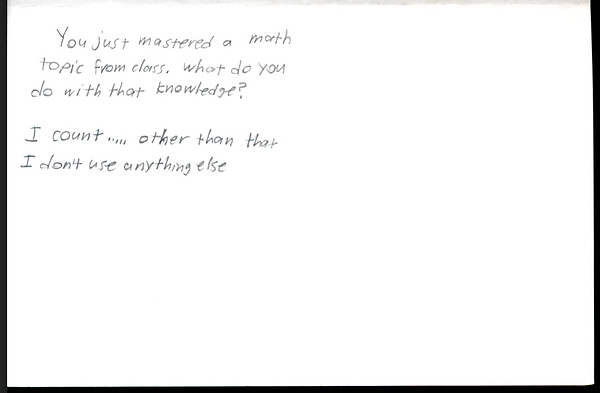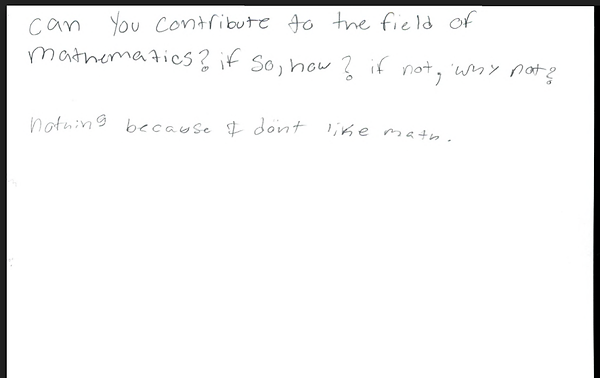Big Idea: After assessing and analyzing my students' existing levels of intellectual autonomy, I draw on the literature to find ways of increasing that autonomy. I end up discovering a deep link between the worlds of differentiation and intellectual autonomy.
Roadmap:
-
Background
-
Data Analysis
-
Connection to Literature
-
Reflection and Next Steps
References: Betts (2004), Martinek et al. (2016), Bender (2012), Ford (2012), Government of New South Wales (2021)

Background
Key Idea: To evaluate my students' existing ability to be intellectually autonomous, I created an informal assessment consisting of four written-response questions that could gauge that autonomy.
My previous artifact analysis showed me that there was a wide spread of ability and comfort level with autonomy among my students. The ratings were all over the board, from 1 to 5 for most of the survey questions. Although the artifact was helpful in getting a better sense of my students’ perceptions, I felt as though it did not provide a specific enough view of what exact kinds of support my students might benefit from. Thus, I decided to collect an informal assessment of my students’ autonomy.
The assessment I gave consisted of four questions. First, I asked what my students would do if there was a math topic that interested them. The goal of this question was to gauge their ability to learn autonomously, when motivated to do so. Second, I asked what my students would do with math knowledge once they mastered it. I wanted to see if they would find ways to autonomously apply the material, or if they did not think of that next step. Third, I asked if my students could contribute to the field of mathematics. In essence, I was asking about their ability to autonomously create knowledge. Finally, I asked how difficult it was for my students to answer the first three questions. This meta-question was in place to check that my students understood what I was asking, and to gauge if their answers were certain (and thus more reliable) or not.
Data Analysis
Key Idea: Although my students are somewhat familiar with autonomous learning, the lack of differentiation supports hindered their ability to autonomously apply or create mathematical knowledge.
I will endeavor to categorize the responses to each question in turn, before looking for patterns between them. On the first question, a vast majority of students listed out resources that they would autonomously look to in order to learn more about math topics. These included the internet, Google, Youtube, Wikipedia, BrainPop, and Khan Academy. Interestingly enough, only three students (3, 8, 9) mentioned asking the teacher at all, and two of those three still listed autonomous learning sources. However, a few students (11, 12, 13) did not seem to have an answer for potential knowledge sources.

On the second question, quite a few students said that they would apply the knowledge they learn in some form, with several specifically mentioning its application to real-world problems. However, three students (4, 6, 15) said that they would not do anything with their knowledge. The remaining responses were quite surprising to me. Students 7, 10, and 17 wanted to apply math specifically to their future careers; students 8, 9, and 13 wanted to use math to improve themselves; and students 14 and 18 wanted to share their math knowledge with others.

On the third question, almost every student said they could not contribute to the production of math knowledge, either because of a lack of interest or a perceived lack of ability. Only students 8, 9, and 12 talked about using their knowledge to generate further knowledge, and student 1 mentioned contributing to math by applying it to situations that could help other people. Although the majority response was not too surprising because knowledge creation is not often touched upon in traditional schooling, the sheer number of students who felt powerless or disinterested was a bit of a shock.

For the meta-question, none of the students found the questions particularly difficult to answer. In fact, a vast majority said the questions were quite easy, citing how well they knew themselves, their relationships with math, or even their own past musings on similar questions. This is an important result; it shows that the responses to the other questions are quite reliable, because my students understood what was being asked of them and were confident in their answers.

Looking through the different questions, it appears as though there is a gradient of ability and comfort level with the various kinds of autonomy. My students seem to have little problem with autonomous learning, possibly some trouble with autonomous application, and a lot of trouble with autonomous creation.
I believe my autonomy support over the course of this unit had some role in that disparity. I encouraged students to explore different online resources of their choosing, and I had them apply binomial distributions to their own interests; but I failed to show how that connection could be used to push the boundaries of mathematical knowledge. In fact, most of my students were already creating knowledge as they applied binomial distributions to topics that are not traditionally associated with them, such as anime, art, sports, video games, work, and medicine. In the future, I can look for ways to assign competence to their knowledge creation, emphasizing that the work they produce is valuable not only to themselves, but to the greater community should they decide to release it.
Connection to Literature
Key Idea: Drawing on Betts (2004), Martinek et al. (2016), Bender (2012), Ford (2012), and the Government of New South Wales (2021), I can help my students make the full transition to intellectual autonomy by providing appropriate differentiation supports, bridging the gap between these two seemingly disparate topics.
Now that I have a clearer picture of where my students stand with intellectual autonomy, I can start to look for ways in which to increase it. Here I will rely on my academic research, in order to source some strategies that I might try in the future. One study that stands out is the Betts (2004) paper about leveraging levels of differentiation to promote student autonomy. Betts recommends that teachers use both group-level and individual-level differentiation, depending on the students, to efficiently achieve maximum overall autonomy without sacrificing too much classroom time. Since many of my students responded positively to autonomous learning and application, for example, I can use group-level differentiation to keep them on those tracks, while focusing more of my attention on individually-differentiated instruction for the few students who responded negatively.

Of course, this then begs the question – what kinds of differentiation actually result in increased autonomy? I turn to the Martinek et al. (2016) study, which demonstrates how autonomy is achieved via differentiation strategies that result in increased access, motivation, and self-regulation. These happen to be the exact outcomes of the differentiation techniques proposed by the other research sources, such as Bender (2012), Ford (2012), and the Government of New South Wales (2021). In other words, this bridges the gap between differentiation and autonomy! By leveraging the strategies for SPED, ELL, and math ability differentiation, I can help my students access the pathways that contribute to increased mathematical autonomy.
Reflection and Next Steps
Key Idea: This artifact has bridged the gap between differentiation and intellectual autonomy, so the natural next step is to enact differentiation supports for my students and determine whether or not it positively impacts their autonomy.
This artifact proved incredibly useful to analyze in writing, not only because of the insights it provides into the exact kinds of autonomy my students are comfortable with, but also because it acted as a springboard for me to think about how I might increase that autonomy. By combining research from different fields about two seemingly disparate subjects, I have reached a potential pathway for fostering my students’ autonomy.
The next step from here is clear – to try out my theory. If I use intentional group-level and individual-level differentiation when I provide my students with autonomy support, will they actually feel more supported? Will they perceive themselves as being better at, and more comfortable with, intellectual autonomy? During the next unit we cover, I will look for ways in which I can incorporate differentiation strategies into my autonomy supports. I will need to think about how I can evaluate whether or not that differentiation makes a difference. There is always a chance it does not, in which case I will need to consider alternate avenues through which I can promote my students’ level of overall intellectual autonomy.

